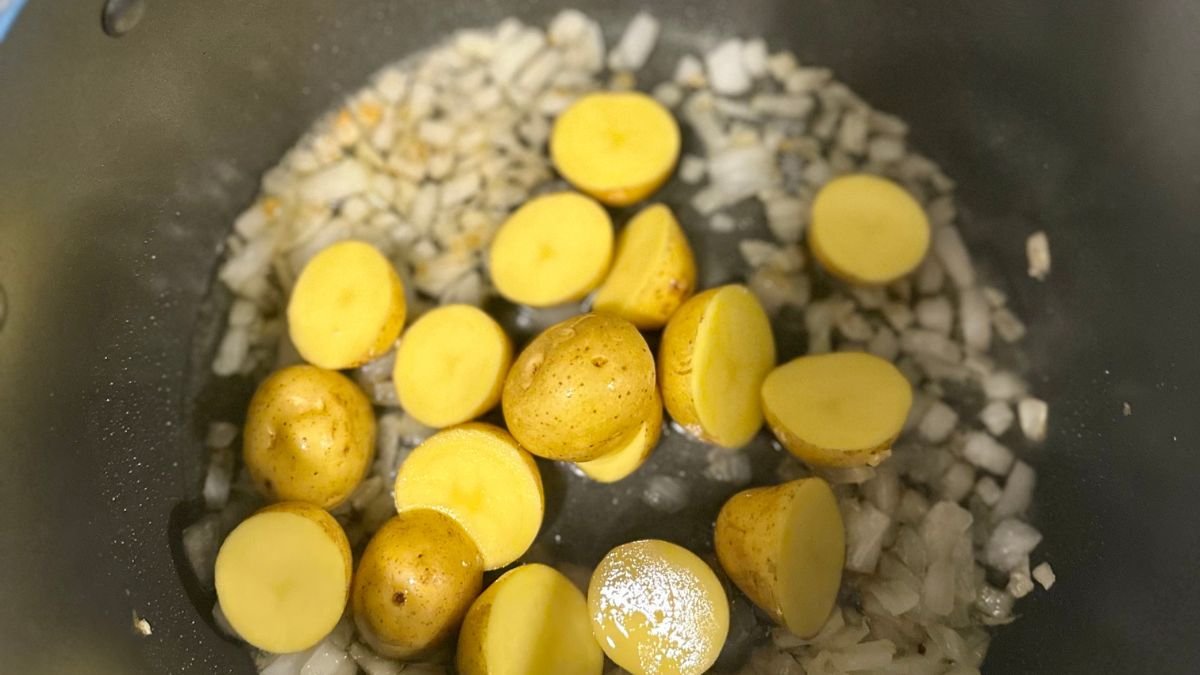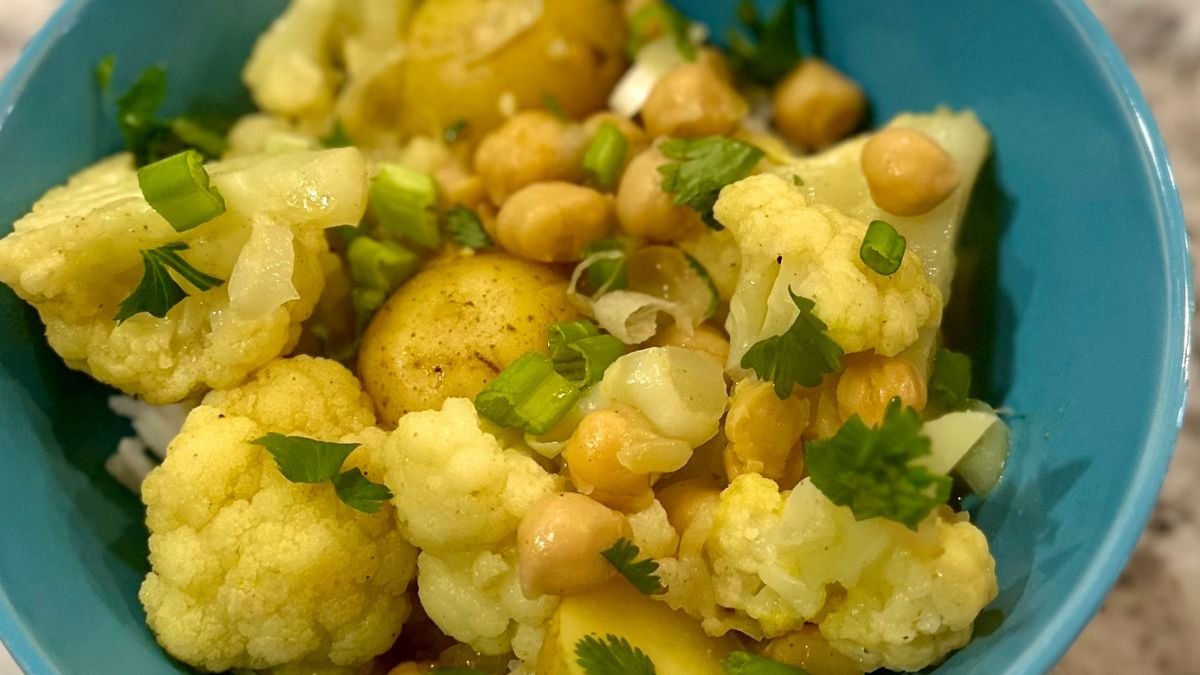Cauliflower and New Potato Curry Daniel Fast Recipe
Looking for more filling and nutritious Daniel Fast recipe ideas? This delicious cauliflower and new potato curry with coconut milk is perfect for this fasting practice. Hearty vegetables and potatoes are great for keeping you full and satiated when you're fasting.
Packed with wholesome ingredients, this dish satisfies your taste buds and nourishes your body.
This blog post will discuss cauliflower's nutritional benefits, step-by-step preparation, serving variations, and proper storage method for this Cauliflower and New Potato Daniel Fast recipe.
Note: this post contains Amazon affiliate links providing a small compensation at no additional cost to you; please read our Disclosure Policy.
Cauliflower and New Potatoes Daniel Fast Recipe
Serves 4
Ingredients:
2 tablespoons olive oil or coconut oil
1 cup yellow onion, chopped
2 cloves garlic, minced
2 teaspoons fresh ginger, chopped
1 tablespoon curry powder
1 teaspoon paprika
1 teaspoon chili powder (optional)
1 head cauliflower, chopped into bite-sized pieces
6 ounces new potatoes, halved
14-ounce can chopped or diced tomatoes
1/2 cup water
7 ounces coconut milk
Salt and freshly ground black pepper
chopped fresh cilantro for garnish
Instructions:
Heat two tablespoons of oil in a large pot over medium heat. Add the chopped onion, garlic, and ginger (if using) and sauté for 4-5 minutes until they soften.
Add curry powder, paprika, and chili powder (if using) to the pot and stir well. Cook for another minute or until fragrant.
Add cauliflower, potatoes, chopped tomatoes, and water to the pot.
Cover the mixture and simmer gently for 15-20 minutes or until the vegetables are tender.
Stir in coconut milk and season with salt and pepper to taste. Simmer for another 5-10 minutes. Don't overcook the cauliflower, or it will get mushy.
Serve hot, garnished with chopped cilantro.
Recipe Notes:
You can add more spice to this dish by adding a chopped jalapeno to step one. You could also add some red pepper flakes for an extra kick.
If you don't have new potatoes, you can use any type of potato chopped into 1-2 inch pieces. If the potatoes are big, they may need extra cooking time. You can cook the potatoes for 5-10 minutes before adding the cauliflower because it will cook faster and may get mushy.
Curry powder can be increased or decreased, this depends largely on the intensity of flavor you like, and since cauliflower and potato are bland they can absorb flavor more quickly.
If you don't like cilantro, you can substitute it with parsley or omit it altogether.
This dish tastes even better when it has time to sit, so the flavors have had time to develop.
If you enjoy this recipe, you will also like one of my favorites, which is very similar in ingredients and cooking process:
Daniel Fast Cashew Chickpea Curry
Find more Daniel Fast-friendly meal ideas on our Daniel Fast recipes page.
Or check out this 7-day Daniel Fast meal plan and shopping list.
Prepping Cauliflower
Cauliflower is an excellent addition to any meal plan; let's dive into how you can prepare it at home.
Chopped Fresh Cauliflower: You can find prewashed and chopped cauliflower in most produce sections. It will come in a bag.
Fresh Whole Cauliflower: You can buy a whole head of cauliflower and prepare it to use in recipes. Rinse the cauliflower under cold water and pat dry with paper towels. Remove any leaves and trim off the stem at the bottom. Then chop into florets.
Frozen Cauliflower: If you're short on time or don't want to deal with the mess of chopping, frozen cauliflower is an alternative. It's already chopped and ready to cook. The downside is that frozen cauliflower can turn mushy once defrosted and cooked.
Cutting cauliflower florets can be messy, but it doesn't have to be. Here are a few tips to make it cleaner and more manageable.
Start by removing the leaves and stem. Then, instead of cutting from the top down, turn the head upside down and cut into the stem. This will allow you to pull the florets apart, reducing the number of small pieces that can create a mess.
Ensure your knife is sharp to make clean cuts and reduce the crumbs.
Also, consider doing the cutting inside a large bowl or over a clean kitchen towel to catch any stray pieces.
Option: Add chickpeas or white beans for more protein.
Serving Variations for Cauliflower and Potato Curry
While the dish is delightful on its own and can be eaten as a soup or stew, you can also serve it with some whole grains or additional side dishes to make it more filling.
Serve cauliflower and potato curry over rice. This is probably the most common option. Prepare some basmati rice, and serve the curry over it. You can also mix the rice into the curry to make a one-pot meal.
Serve over a whole grain like quinoa or farro. If you're looking for more nutrients and fiber, try serving the curry over a whole grain like quinoa or farro. To mix things up, you can use any whole grain, even bulgur or barley.
Add some protein. If you're on a vegan or no animal product plan, then you could top this dish with chickpeas or white beans. You could also include tofu or some nuts like cashews. For those eating meat, top the curry with grilled chicken, shrimp, fish, or beef.
**Serve as a side dish to your favorite protein. If you don't want to mix up the proteins in your meal, then consider serving this curry as a side dish. It goes well with almost anything and can
Serve with a side salad. To balance out the richness of the curry, consider serving it with a fresh side salad. This can be as simple as a mixed greens salad or something more creative like a spicy mango and cucumber salad.
Storing Your Daniel Fast Cauliflower and New Potatoes
To make the most of this dish, proper storage is key.
Refrigeration: Allow the dish to cool completely before transferring it to an airtight container. Refrigerate for up to 3 days.
Freezing: While this dish could be frozen, keep in mind that the texture of cauliflower may change upon thawing. Freeze in portions for up to 2 months, reheating gently on the stovetop. Another option is to make without cauliflower and freeze and then add fresh cauliflower when reheating on the stove, gently simmering the dish for about 15 minutes.
Why Cauliflower is a Nutritional Powerhouse
Let's explore why cauliflower is good for you any time of year. This white veggie belongs to the cruciferous vegetable family and is known for its exceptional health benefits.
Rich in vitamins, minerals, and antioxidants, cauliflower supports overall well-being.
Cauliflower boasts a high nutritional density, meaning it is filled with substantial amounts of vitamins and minerals but low in calories.
It is an excellent source of vitamin C, which helps boost the immune system and supports collagen production. The vegetable is also rich in vitamin K, which is vital for bone health and necessary for blood clotting.
Plus, cauliflower provides significant amounts of fiber. This dietary component aids in digestion helps maintain a healthy weight, and lowers the risk of heart disease.
Also noteworthy is the presence of antioxidants, specifically glucosinolates and isothiocyanates.
Studies suggest that glucosinolates have anti-inflammatory, antioxidant, chemo-protective effects, meaning they may possibly prevent cancer. Research has also shown promising anti-cancer benefits of isothiocyanates (ITCs), which are derived from cruciferous vegetables like cauliflower.
Finally, the choline in cauliflower supports learning and memory, while its abundant supply of sulforaphane has been seen to have neuroprotective effects. Thus, incorporating cauliflower into your diet supports not just physical health but cognitive health as well.
To sum up.
Nutritional Benefits of Cauliflower
Vitamins and Minerals: Cauliflower is an excellent source of vitamins and minerals that boost your immune system and bone health. One cup of chopped cauliflower contains the following for % Daily Value based on 2,000 calorie diet:
85% Vitamin C
10% Vitamin B6
9% Potassium
4% Magnesium
2% Iron
10% Adequate Intake (AI) Choline
Antioxidants: It contains antioxidants like glucosinolates, flavonoids, and carotenoids, which help combat oxidative stress and inflammation in the body.
Fiber: Fiber supports digestive health, aiding in regular bowel movements and promoting a feeling of fullness. You'll find 2 grams of fiber per cup of raw cauliflower.
Low in Calories: For those watching their calorie intake, cauliflower is a great choice, allowing for guilt-free enjoyment. Cauliflower has just 27 calories per cup!
Understanding the Daniel Fast
The Daniel Fast is a spiritual discipline that involves abstaining from certain foods for a specified period and is based on the biblical story of Daniel.
Participants typically consume whole, plant-based foods while avoiding processed foods, baked goods, and animal products.
Christian fasting enhances spiritual growth, discipline, and overall well-being.
You can find many more resources on the Daniel Fast from our Fasting page and can read over 52 Bible verses on fasting.
Enjoy this Dish Anytime!
In conclusion, this Daniel Fast Cauliflower and New Potatoes recipe not only adheres to the principles of the Daniel Fast but also celebrates the goodness of cauliflower.
Whether you're participating in a fast or simply seeking a nourishing plant-based meal, this dish is a delightful addition to your culinary repertoire. Explore the versatility of cauliflower, savor the flavors, and nourish your body with this wholesome recipe.



